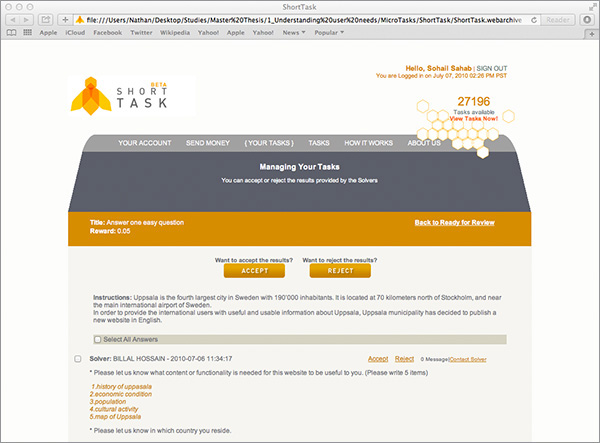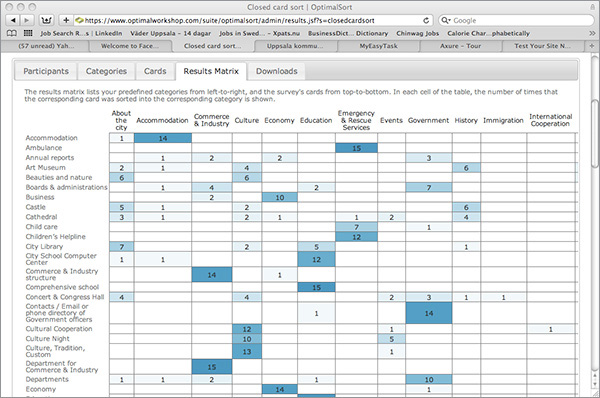Remote User-Centred Design
Redesign of Uppsala Kommun (Municipality) International Website
To meet the needs of the international users and design a usable website, I decided to employ user-centred design (UCD). However, how could I conduct UCD while users were geographically spread out?
To answer this question and redesign the website I studied and employed different approaches to carry out UCD remotely.
Phase 1: Knowing users and understanding their needs
Meetings at Uppsala Kommun
I started with meetings at Uppsala Kommun to gather information about possible visitors of the website and their required information, as well as the target groups of interest to Uppsala Kommun. Furthermore, I wanted to understand the structure of the existing website and the way they provided and managed information.
Examining Uppsala Kommun internal search log

I then examined internal search log within a period of one year to see what visitors were searching for.
Examining Google Analytics

I also checked the visited pages within a period of two months using Google Analytics.
Examining Google Insights for Search

Besides, I used Google Insights for Search to find out what kind of information about Uppsala city was being searched on Google.
Examining forums about Uppsala
I also examined several forums about Uppsala to find out what people wanted to know about it.
Conducting survey on the existing English website of Uppsala Kommun


In another approach, I conducted a survey with the help of Uppsala Kommun on the existing English website to find out what kind of information users were looking for, as well as if they were able to find it. We placed the following question on top of every page:
“Could you find what you were looking for? Yes/No”
Selecting “No” would lead them to the survey. We thanked them for their participation if they selected “Yes”.
Conducting survey on three “Micro Task Sites”

I also conducted a survey on three sites on which crowdsourcing tasks could be created and publicized, and people could execute the tasks and get paid for it.
The results of the survey on crowdsourcing sites were 66 topics about users’ needs. Among them, there were 19 new topics that had not been identified by means of other approaches.
Contacting officials of other cities
In order to obtain information about the content and functionality that was useful for officials of other cities, I contacted six officials from Iceland, Estonia, Norway, Denmark, Finland, and Ukraine and asked them about their needs.
Examining the existing content of English website of Uppsala Kommun
Finally I examined the existing content of English website and extracted the main topics.
Result

The outcome of the first phase was the “Table of possible content” showing 98 topics resulted from different employed approaches.
Phase 2: Organizing the content
I used the resulted possible content from the first phase and conducted remote card sorting with participants from crowdsourcing sites to organize it.
Remote open card sorting


I conducted a remote open card sorting with 30 participants from a crowdsourcing site to find out how they group the cards and what names they choose for the groups.
Remote closed card sorting

I subsequently conducted a remote closed card sorting with 15 participants to check the result of the open card sort and get some additional feedback.
The outcome of remote card sorting with participants whom I recruited from crowdsourcing sites was acceptable. For instance, all 15 participants in closed card sorting placed “Universities/Educational Institutes” under “Education”, or “Political administration” under “Government”.
Result

The result of the second phase was the “Table of Possible Information Architecture”. This was not only based on the outcome of card sorting. For instance, although most participants placed “Professional study visit” under “Education”, since I knew that the topic was mainly of interest to officials of other cities, I placed it under “International Cooperation”, and at the same time under “Education” as a related topic.
Phase 3: Prototyping and evaluating the prototypes
Prototyping

After sketching different prototypes, we chose two to evaluate with users. I then made two interactive wireframes, each with more than 100 pages and 200 links.
Remote usability testing

I evaluated the interactive wireframes using the unmoderated user testing service provided by Loop11 (www.loop11.com). I recruited 40 participants for the test from two crowdsourcing sites.
The goals of the study were:
1. Evaluating the information architecture.
2. Evaluating the general layout and navigation.
3. Comparing the effectiveness of two prototypes.
4. Providing causal hypothesis for probable obstacles to performing the evaluated tasks.
5. Creating a repeatable usability study protocol.
Result
I documented and presented the result of usability testing, including issues and recommendations, as well as the suggested information architecture and content to the Uppsala Kommun.
Conclusion
It is possible to conduct UCD remotely. However, special consideration should be taken for finding representative users.
I used crowdsourcing sites to recruit participants from different countries to conduct UCD remotely. I asked these participants about their needs, designed the information architecture and evaluated the prototypes with them for marginal costs and within a timeframe of several days for each phase.
Finally, Remote UCD is not a substitute for UCD. It can be considered as an approach for situations where users are geographically spread out. It can also be used as a complementary approach to UCD.


